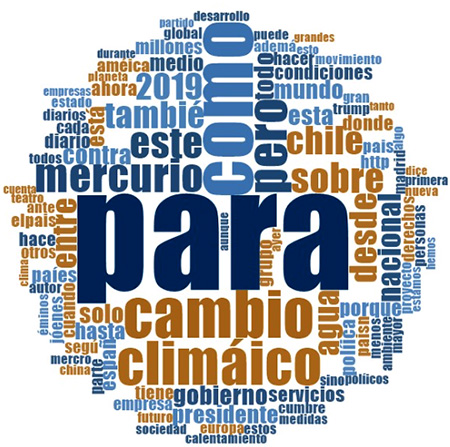Monthly Summaries
Issue 27, March 2019
[DOI]

Flooding in Hamburg, Iowa, on March 18, 2019. Photo: Tim Gruber for The New York Times.
-
March 2019 coverage was up 25% from February 2019, and nearly doubled from the amount of media attention to climate change or global warming in March 2018.
-
March 2019 coverage was up 5% in Africa, up 9% in Oceania, up 19% in Asia, up 27% in the Middle East, and up 48% in Central/South America compared to the previous month. Among monitoring at the country level, coverage increased 4% in Australia, 10% in Germany, 12% in the United Kingdom (UK), 17% in Canada, 20% in India, 21% in New Zealand and 25% in the United States (US).
-
Among the four wire services we now monitor, there was a 55% increase in March 2019 coverage of climate change or global warming from February 2019 coverage, and nearly a doubling of coverage from March 2018 levels.
March media attention to climate change and global warming increased in all regions and all countries monitored throughout the world from the previous month of February.
Figure 1 shows increases and decreases in newspaper media coverage at the global scale – organized into seven geographical regions around the world – from January 2004 through March 2019.
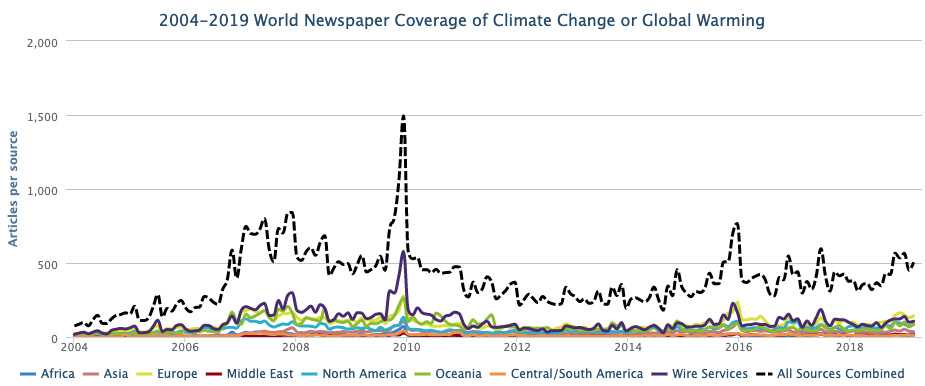
Figure 1. Newspaper media coverage of climate change or global warming in sources – sorted into seven different regions – around the world from January 2004 through March 2019.
Figure 2. Word cloud showing frequency of words (4 letters or more) invoked in media coverage of climate change or global warming in thirteen Spanish- and Portuguese-language newspaper sources across ten Latin American countries in March 2019. |
Figure 2 shows word frequency data in thirteen Spanish- and Portuguese language Latin American newspapers in March 2019. Data are from searches of the terms ‘cambio climático’ or ‘calentamiento global’ in twelve sources in El Universal (México), Reforma (México), La Nación (Costa Rica), El Comercio (Perú), El Comercio (Ecuador), El País (Uruguay), La República (Uruguay), El Tiempo (Colombia), La Razón (Bolivia) La Nación (Argentina), El Nacional (Venezuela), and El Mercurio (Chile), and from ‘mudanças climáticas’ or ‘aquecimento global’ in O Globo (Brazil).Of note, in these searches across thirteen sources in ten countries – México, Costa Rica, Brazil, Venezuela, Colombia, Bolivia, Perú, Uruguay, Argentina and Chile – ‘Trump’ was just the 63rd most frequently invoked term across the 182 articles in March. This provides some additional evidence that the ‘Trump Dump’ (where media attention that would have focused on other climate-related events and issues instead was placed on Trump-related actions, leaving many other stories untold) phenomena may be largely confined north of the United States (US) border in 2019 (a mention every fourth article on average contrasted with approximately five mentions per article in the US press). Also, in March 2019 coverage of climate change or global warming in these sources went up 48% from the previous month of February 2019. Coverage also doubled in these sources in March 2019 from March 2018.
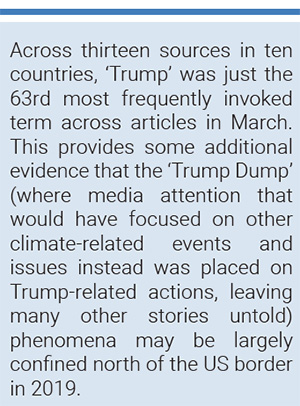 Moving to considerations of content within these searches, in March ecological and meteorological connections to climate issues populated overall coverage. For example, record-setting flooding in the US – particularly in the Midwest states of Wisconsin, Iowa and Nebraska – was covered, many stories making links to flood events and a warming world. For example, John Schwartz from The New York Times wrote, “Vast areas of the United States are at risk of flooding this spring, even as Nebraska and other Midwestern states are already reeling from record-breaking late-winter floods, federal scientists said on Thursday… More rainfall in the Midwest is a predictable consequence of climate change, according to the most recent National Climate Assessment, which was produced last year by 13 federal agencies. A warmer atmosphere can hold more moisture, which comes down as precipitation.
Moving to considerations of content within these searches, in March ecological and meteorological connections to climate issues populated overall coverage. For example, record-setting flooding in the US – particularly in the Midwest states of Wisconsin, Iowa and Nebraska – was covered, many stories making links to flood events and a warming world. For example, John Schwartz from The New York Times wrote, “Vast areas of the United States are at risk of flooding this spring, even as Nebraska and other Midwestern states are already reeling from record-breaking late-winter floods, federal scientists said on Thursday… More rainfall in the Midwest is a predictable consequence of climate change, according to the most recent National Climate Assessment, which was produced last year by 13 federal agencies. A warmer atmosphere can hold more moisture, which comes down as precipitation.
Also in March, an East African cyclone named ‘Idai’ – with damage most concentrated in Mozambique – prompted further articulations in media accounts of links between extreme events and a changing climate. Journalist Ruth Maclean from The Guardian reported on Monday, March 18 that Mozambique President “Filipe Nyusi told Mozambican radio he had seen ‘many bodies’ floating in the overflowing Pungwe and Busi rivers. “It appears that we can register more than 1,000 deaths,” he said, adding that more than 100,000 people were at risk because of severe flooding. At least 215 people have been confirmed dead and hundreds are missing across Mozambique, Malawi and Zimbabwe from Tropical Cyclone Idai, according to government agencies and the Red Cross, which said 1.5 million people had been affected.” Furthermore, journalist Jeffrey Gogo from The Herald in Harare, Zimbabwe observed, “On March 15, Harare woke up to some light winds in overcast conditions – as per the MSD’s [Meteorological Services Department] predictions. It drizzled in a few places. But it is the high risk areas such as Muzarabani or Chibuwe or Chisumbanje were the greatest concern lies, in the likely event of the tropical cyclone resulting in flash flooding at the scale of the havoc it has wrought in Mozambique…once again, this will be a litmus test for Zimbabwe’s preparedness to handle disaster situations, which, as a result of climate change, have become more frequent, intense and damaging”. And the Business Day newspaper based on Johannesburg, South Africa carried a story by Matthew Hill and Godfrey Marawanyika with Ana Monteiro from Bloomberg who noted, “The country is the third-most vulnerable on the continent to climate change, according to the Global Facility for Disaster Reduction and Recovery”. Two days later (March 20), reporters Tara John and Anna Cardovillas from CNN communicated that Amnesty International “urged authorities in Mozambique and Zimbabwe, countries that are prone to flooding, to adopt climate change policies that could reduce the impact of these events”, quoting Muleya Mwananyanda Amnesty International's deputy regional director for southern Africa who declared, "As the effects of climate change intensify, these extreme weather conditions can be expected to revisit us more frequently. The devastation wrought by Cyclone Idai is yet another wake-up call for the world to put in place ambitious climate change mitigation measures”.
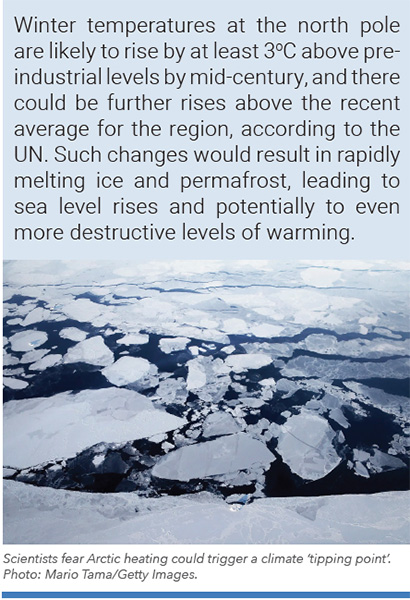 March media accounts also focused on primarily scientific dimensions of climate change and global warming. For example, a United Nations Environment report about wintertime warming in the Arctic garnered media attention early in the month. The report noted that Arctic temperatures were on pace to rise 3-5oC by mid-century, even with Paris Agreement-level engagement. They noted that such warming risks permafrost melt and consequent large releases of trapped methane which would then further amplify warming (a positive feedback). Journalist Fiona Harvey from The Guardian reported, “Sharp and potentially devastating temperature rises of 3oC to 5oC in the Arctic are now inevitable even if the world succeeds in cutting greenhouse gas emissions in line with the Paris agreement, research has found. Winter temperatures at the north pole are likely to rise by at least 3oC above pre-industrial levels by mid-century, and there could be further rises to between 5oC and 9oC above the recent average for the region, according to the UN. Such changes would result in rapidly melting ice and permafrost, leading to sea level rises and potentially to even more destructive levels of warming. Scientists fear Arctic heating could trigger a climate “tipping point” as melting permafrost releases the powerful greenhouse gas methane into the atmosphere, which in turn could create a runaway warming effect”.
March media accounts also focused on primarily scientific dimensions of climate change and global warming. For example, a United Nations Environment report about wintertime warming in the Arctic garnered media attention early in the month. The report noted that Arctic temperatures were on pace to rise 3-5oC by mid-century, even with Paris Agreement-level engagement. They noted that such warming risks permafrost melt and consequent large releases of trapped methane which would then further amplify warming (a positive feedback). Journalist Fiona Harvey from The Guardian reported, “Sharp and potentially devastating temperature rises of 3oC to 5oC in the Arctic are now inevitable even if the world succeeds in cutting greenhouse gas emissions in line with the Paris agreement, research has found. Winter temperatures at the north pole are likely to rise by at least 3oC above pre-industrial levels by mid-century, and there could be further rises to between 5oC and 9oC above the recent average for the region, according to the UN. Such changes would result in rapidly melting ice and permafrost, leading to sea level rises and potentially to even more destructive levels of warming. Scientists fear Arctic heating could trigger a climate “tipping point” as melting permafrost releases the powerful greenhouse gas methane into the atmosphere, which in turn could create a runaway warming effect”.
As another example, a report from the Associated Press emitted in March then generated attention across multiple media sources, cascading into many other regional and local outlets. This report noted that urban heat records – noted in over 400 weather stations over the past two decades across the US – have been broken two times more frequently than cold weather records. Seth Borenstein and Nicky Forster from the Associated Press reported, “Over the past 20 years, Americans have been twice as likely to sweat through record-breaking heat rather than shiver through record-setting cold, a new Associated Press data analysis shows. The AP looked at 424 weather stations throughout the Lower 48 states that had consistent temperature records since 1920 and counted how many times daily hot temperature records were tied or broken and how many daily cold records were set. In a stable climate, the numbers should be roughly equal. Since 1999, the ratio has been two warm records set or broken for every cold one. In 16 of the last 20 years, there have been more daily high temperature records than low”.
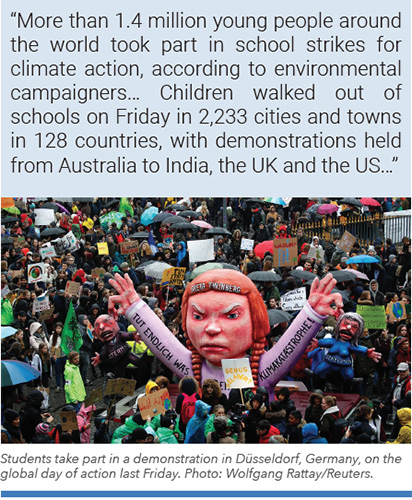 Stories in March also picked up on cultural themes. For example, the student strike across one hundred countries on March 15 provided fodder for news coverage. Catalyzed by 16-year-old Swedish student Greta Thunberg (who was nominated in March for a Nobel Peace Prize as well), young people walked out of schools and demonstrated their dissatisfaction for inadequate policy action in the face of 21st century climate change. Damian Carrington from The Guardian observed, “More than 1.4 million young people around the world took part in school strikes for climate action, according to environmental campaigners…Children walked out of schools on Friday in 2,233 cities and towns in 128 countries, with demonstrations held from Australia to India, the UK and the US…”
Stories in March also picked up on cultural themes. For example, the student strike across one hundred countries on March 15 provided fodder for news coverage. Catalyzed by 16-year-old Swedish student Greta Thunberg (who was nominated in March for a Nobel Peace Prize as well), young people walked out of schools and demonstrated their dissatisfaction for inadequate policy action in the face of 21st century climate change. Damian Carrington from The Guardian observed, “More than 1.4 million young people around the world took part in school strikes for climate action, according to environmental campaigners…Children walked out of schools on Friday in 2,233 cities and towns in 128 countries, with demonstrations held from Australia to India, the UK and the US…”
Reverberations from the events were observed through concatenate media reports in mid-March. For example, journalist Lindsay Brown from the BBC commented on local governments in the UK taking action, noting, “There's no single definition of what that means but many local areas say they want to be carbon-neutral by 2030. Some councils have promised to introduce electric car hubs or build sustainable homes to try to achieve that goal. It's a much more ambitious target than the government's, which is to reduce carbon emissions by 80% (compared to 1990 levels) by 2050”.
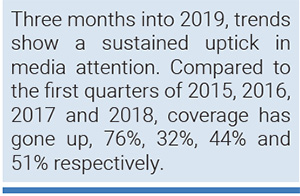 In March, considerable attention continued to be paid to political and economic content of coverage. For example, the Norwegian government’s decision to divest from oil and gas investments got media notice in the public sphere. Journalist Sarah McFarlane from The Wall Street Journal reported, “Norway’s $1 trillion sovereign-wealth fund took a major step toward selling off some of its substantial holdings in oil-and-gas companies, a move to shield the oil-rich nation from the risk of permanently lower crude prices. The Norwegian finance ministry proposed that the fund remove energy-exploration and -production companies from its portfolio, following a 2017 recommendation made by the central bank, which uses the fund to invest the proceeds of the country’s oil industry”.
In March, considerable attention continued to be paid to political and economic content of coverage. For example, the Norwegian government’s decision to divest from oil and gas investments got media notice in the public sphere. Journalist Sarah McFarlane from The Wall Street Journal reported, “Norway’s $1 trillion sovereign-wealth fund took a major step toward selling off some of its substantial holdings in oil-and-gas companies, a move to shield the oil-rich nation from the risk of permanently lower crude prices. The Norwegian finance ministry proposed that the fund remove energy-exploration and -production companies from its portfolio, following a 2017 recommendation made by the central bank, which uses the fund to invest the proceeds of the country’s oil industry”.
Three months into 2019, trends show a sustained uptick in media attention. Compared to the first quarters of 2015, 2016, 2017 and 2018, coverage has gone up, 76%, 32%, 44% and 51% respectively. Stay tuned for what comes next. We at MeCCO will monitor and report on the trends and themes among these stories as they develop.

